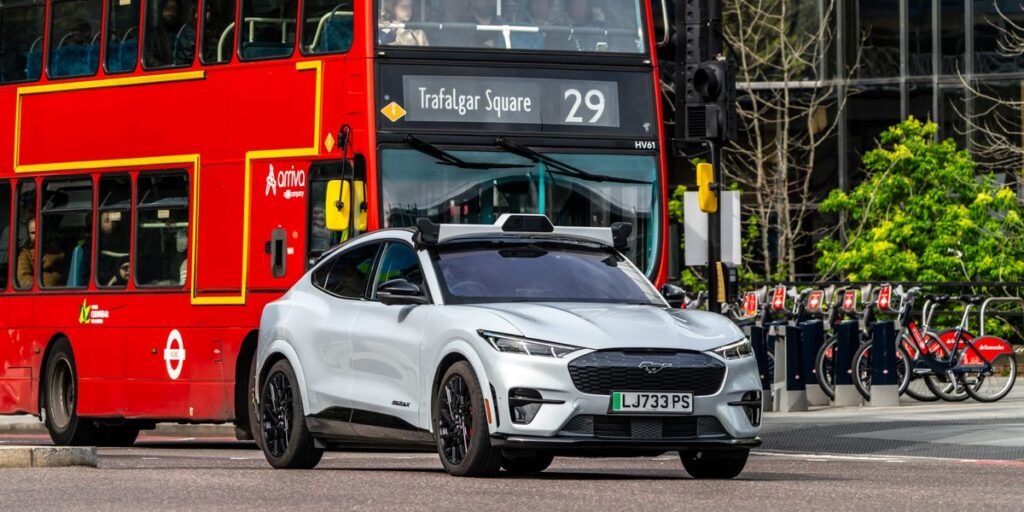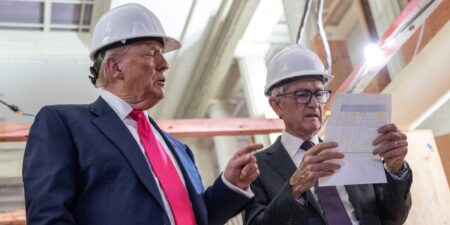Self-driving taxis are now a common sight on the streets of San Francisco and Shanghai — but in London, the city’s famous black cabs still rule the roost.
That may not be the case for much longer. Earlier in June, Uber announced it would begin trialling driverless taxis in the UK’s capital, in partnership with Microsoft and Nvidia-backed self-driving startup Wayve.
As the two companies prepare to launch their robotaxi service, I took a test drive through the busy streets of central London in one of the self-driving Ford Mach-Es Wayve has been testing in the city.
The robotaxi dealt with everything London’s chaotic driving environment could throw at it, with Wayve CEO Alex Kendall, who joined for the ride, saying it was one of the more eventful trips he’d taken.
Robot, take the wheel
After a quick look around Wayve’s Kings Cross base, we hopped in a Ford Mach-E equipped with the company’s “AI driver” self-driving system.
Wayve’s upcoming robotaxi service with Uber will be fully driverless, but for now, the company is testing with safety drivers who take over if the robotaxi runs into problems.
I sat in the front seat, alongside a big red button that disengages the self-driving system (the safety driver on my ride said he’d never had to use it).
The driver drove us out of the gates of Wayve’s HQ and then, with a sharp buzzing noise, he removed his hands from the wheel, and the robotaxi took over.
London’s streets are famously complex, so much so that taxi drivers are required to learn thousands of them off by heart in a 150-year-old exam known as “The Knowledge.”
The city’s hodgepodge of Roman and Victorian roads are a mess of cycle lanes and pedestrian crossings, with complex road layouts that often serve more as a rough guide than a rulebook for the millions of drivers passing through the city each day.
For Wayve, that complexity is the point. The company says its AI driver — which runs on an end-to-end AI model, an approach also adopted by Tesla — is capable of generalizing and reacting to the physical world in the same way a human would, unlike rivals like Waymo, which rely on high-definition maps and sensors.
Kendall said that this allows Wayve’s software to drive anywhere, even places it hasn’t seen before, and deal with the kind of unexpected encounters that are an everyday occurrence on the streets of a major city like London.
“I can’t wait to see another autonomy company come into London because I think it’s extremely challenging,” said Kendall.
“The advantage of starting in London is that we’ve been forced to develop a system that can operate on complex roads and deal with all of these unexpected scenarios,” he added.
On the road
In the first few minutes of our drive, we encountered multiple jaywalkers, including several who darted out across the street without warning in front of the robotaxi. We also had to inch through narrow gaps between rows of parked cars.
Perhaps understandably, Wayve’s robotaxi was more cautious than your average Uber driver. On one occasion, the robotaxi came to a jerky stop at an amber light when it may have had enough time to go through.
Sometimes, that caution was too much for London’s impatient commuters. One maneuver that saw the car slowly navigate a tight gap between a set of roadworks and a row of traffic drew an irate honk from the car behind, which was clearly keen for us to hurry up.
Wayve has been testing its autonomous vehicles on the streets of London for years, but they still run into the odd surprise. Around halfway into our drive, we came across a roadblock as a team of workers trimmed an overhanging tree.
In the seat behind me, Kendall broke off from answering my question and leaned forward to see how the car would deal with the falling branches and the worker directing traffic — but the robotaxi barely paused, successfully reading hand signals to stop and proceed and accelerating past the quizzical stares of the maintenance crew.
“I’ve never seen that before,” said Kendall as the robotaxi exited the roadblock, also dodging a tractor reversing along the road.
Our route skirted the edge of Soho, London’s central nightlife district, and went past the entrance to the British Museum, a narrow street packed with tourists, taxi drivers, and roadworks.
Perhaps the most impressive moment of the drive came on this road, one of London’s busiest. The robotaxi came to a stop at a crosswalk in near constant use as a huge crowd of pedestrians streamed toward the Museum.
Working out the safe moment to move forward would be daunting even for a human driver, but the car spotted an opening and moved through the zebra crossing quickly, avoiding traffic building up behind us.
“Lots of autonomy systems, I think, would be stuck here for hours,” said Kendall, explaining that moments like this required the robotaxi’s AI software to track and predict the activity of dozens of pedestrians.
A glimpse into the future?
As the drive went on, the activity around us occasionally passed into the bizarre. While coming to a stop at a red light, we narrowly avoided being hit by a small piece of metal that fell off the truck in front as it accelerated away.
A pedestrian crossing at the red light kindly picked up the debris and moved it to the side of the road, but it’s hard to imagine anyone thinking to simulate a situation so surreal.
For Kendall, incidents like this are proof that robotaxis need to get on as many roads as possible.
After opening offices in Canada, the US, and Japan over the last year, Wayve has now tested its vehicles in 90 cities in the past 90 days, from alpine roads in Switzerland and dirt tracks in rural Italy to bustling cities like Tokyo and Vancouver.
Kendall said for some of those places, Wayve had little to no training data, demonstrating the ability of its software to apply what it has learnt to completely new cities and driving environments.
“If robotaxis are just going to be in affluent areas like the Bay Area, then we’ve failed as an industry. We’ve got to make sure this technology is rolled out globally,” Kendall said.
The launch of a driverless ride-hailing service with Uber in London, which will be the first time Wayve has taken the safety driver out of its vehicles, is a big step toward that vision.
Both companies declined to say when the driverless pilots would begin or which automaker would supply the vehicles for the robotaxi fleet, but Kendall described it as a huge moment for the young British startup and the broader industry.
“It’s exciting, it’s my life’s work. Over 99% of road accidents are due to human error, and this technology can eliminate those,” he said.
A long road ahead
My ride in Wayve’s robotaxi ended with the car smoothly negotiating a double roundabout. The safety driver took back control to pull into the company’s headquarters, the first time he’d touched the wheel since we’d left an hour ago.
After 60 minutes of driving around the centre of one of the world’s biggest and most chaotic cities without a hitch, I was impressed, if not completely sold.
While self-driving cars are now a reality, the history of the industry is littered with broken promises, high-profile failures, and impressive tech demos that have failed to pan out.
Saber Fallah, professor of safe AI and autonomy at the University of Surrey, told BI that while Wayve’s AI-focused approach to self-driving was “bold and innovative,” he was skeptical about how soon the company would be able to build a robotaxi network in a city as complex as London.
“Unlike cities like Phoenix, where many Level 4 trials have taken place, London presents an extremely dynamic and unpredictable environment,” said Fallah, adding that the vehicles would need to understand informal social cues and context between drivers and reason about their intent.
Fallah said that one issue with Wayve’s approach is that the “black box” nature of end-to-end AI systems might make it difficult to understand why robotaxis based on this tech make decisions, potentially undermining public trust.
Despite calling the planned robotaxi pilot an “exciting step” for self-driving cars in the UK, Fallah warned that Uber and Wayve would have to navigate challenging liability and regulatory issues while building public confidence in the frontier technology.
“Achieving consistent, safe operation without fallback drivers in central London will be an enormous hurdle,” he added.
Whether Uber and Wayve can run rides like the one I experienced in London a hundred times a day, in rain, sun, fog, and hail, will be the ultimate test.
Until then, Londoners will have to stick to the city’s black cabs and iconic red buses to get around.
Read the full article here
















